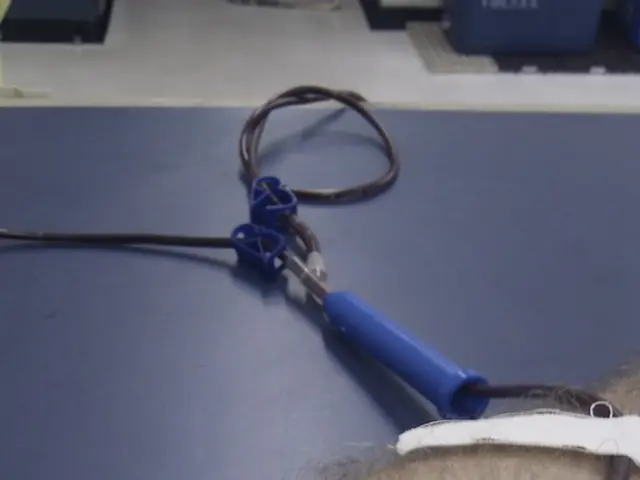Expected recovery timeframe for hip replacement: Insights on the healing process
Revamped Reflections:
Hip replacement surgery recovery pace varies among individuals, with most folks resuming light activities within 3 to 6 weeks post-surgery. Here's a no-frills guide on what to expect during your recovery journey.
Cue Up: Before Surgery
To prepare for a partial or total hip replacement, folks should prep their body a few weeks prior to the surgery. This minimizes complication risks and expedites recovery. Key points to focus on include:- Consult with the healthcare team, learn about the procedure, and do your research.- Engage in leg, core, and upper body strengthening exercises as instructed by your doctor.- Maintain a moderate weight to reduce surgery-related risks.- Kick the smoking habit or at least limit it.- Organize for help with daily tasks and prepare meals ahead for smoother post-surgery handling.- Prepare the home for easy access and convenience: consider using a raised toilet seat, safety bars, a walker or crutches, etc.
Flip the script: Recovery during the First Few Days
After hip replacement surgery, patients might remain in the hospital for 1 to 2 days or potentially leave on the same day.
Doctors will administer pain relief medications, which may include:- Opioids- Local anesthetic- Nonsteroidal anti-inflammatory drugs (NSAIDs)- Acetaminophen
The surgical incision will be either stapled or stitched for about 2 weeks, which may call for home wound care as the medical team will brief.
Professionals will aid patients in getting up and moving around as soon as possible following surgery. This may mean taking assisted steps on the same day of the operation, even if it feels cumbersome initially.
A physical therapist might demonstrate exercises for leg strengthening and provide guidance on what activities to sidestep. They'll likely demonstrate proper sitting and bending techniques to protect the new hip.
Home Sweet Home: Returning Post-Surgery
Individuals may require assistance with day-to-day tasks for several weeks or may need to stay in a rehabilitation facility. Some pain and discomfort can be experienced for a few weeks, and prescribed medications should be taken as directed.
A physical therapist or home health aide might attend to recovery, and patients may attend physical therapy sessions or carry out prescribed exercises at home. Daily exercises facilitate quicker recovery and improve new joint flexibility and strength.
Milestones: 10 to 14 Days Post-Surgery
By the 10 to 14-day mark, the stitches or staples should be removed. At this stage, pain and swelling may decrease, although this might take longer for some. A person's activity level at this juncture may vary, with some individuals becoming more mobile without aid.
Those who previously required a cane or walker might still need it during the early recovery phase.
Sailing Smoothly: More than 2 Weeks Post-Surgery
Within 3 to 6 weeks, many can generally engage in light daily activities, enjoy greater stability, and put more weight on the leg. They may be able to manage basic self-care and light chores.
Most folks feel ready to return to work after 6 weeks, although this can vary. Following 6 to 8 weeks, most can safely have sex again.
Physical therapy should continue for at least two months after surgery, and individuals can consult their doctor about safe exercise alternatives like swimming and walking beyond this period.
Cruising into Recovery: More than 3 Months Post-Surgery
By the 3-month mark, people may be capable of resuming daily activities. They should consult their doctor about when to reduce or discontinue physical therapy and when safe to participate in low-impact sports.
Remember: recovery varies for everyone, so continuous communication with the healthcare team is crucial for progress evaluation and tailored physical therapy recommendations.
Play the Ace: Tips on Aiding Recovery
To better your hip replacement recovery experience, consider incorporating the following strategies:- Adhere to physical therapy routines as directed by your physical therapist.- Explore gentle exercises, such as daily walking and seated exercises.- Maintain a reclined sitting position.- Apply cold compresses to reduce swelling.- Take prescription medications as directed by your doctor.- Utilize walking aids if required.
Who Scores the Ace? Recovery Differs in Older and Younger Folks
Traditionally, specialists have been hesitant to recommend hips replacements for individuals under 20 due to suboptimal outcomes. However, some under-20s might undergo total hip replacements due to a condition called osteonecrosis of the femoral head.
Recently, modern hip replacement implants have led to improved outcomes and survival rates in younger populations. In younger patients, recovery tends to be free of complications, but underlying health issues could affect this.
In older adults, surgery may bear higher complication risks due to possible conditions, such as heart and lung disorders, clogged arteries, and high blood pressure. Always speak with your doctor for diagnostic tests and treatments for these conditions.
Hip Resurfacing Recovery
In hip resurfacing, the femoral head, or hip joint, is trimmed and capped with a smooth metal cover instead of being removed. The damaged cartilage and socket bone are extracted and replaced with a metal shell.
Patients can usually go home within 1 to 4 days after hip resurfacing surgery and may start putting weight on their leg immediately afterward, though walking aids like a walker, cane, or crutches may still be needed for the first few days or weeks.
People might experience pain and discomfort for several weeks after surgery and may require NSAIDs or opioids for severe pain relief. Physical therapy is recommended post-surgery, and exercises to preserve range of motion and restore strength are essential.
The Big Picture: Hip Replacement Surgery Outlook
Post-hip replacement surgery, individuals experience:- Less pain- Improved mobility- Better quality of life- Improvements in daily activities
However, there may be some long-term effects and restrictions, including persistent numbness, pain, or stiffness around the incision site.
• follow physical therapy exercises as a physical therapist instructs• try other gentle exercises, such as daily walking• sit in a reclining position• use a cold compress to reduce swelling• take any prescription medications as a doctor instructs• use walking aids, such as crutches, if necessary
Hip replacements may also affect aspects of one's life, such as the need to inform metal detectors about the replacement, the increased risk of falls or injury during high-impact sports, and the recommendation for antibiotics before certain dental procedures.
Sexual activity can be resumed around 6 weeks post-surgery, with caution, and appropriate precautions, like using supportive cushions and adopting safe positions.
Frequently Asked Questions
Q: How long will it take to walk again after a hip replacement?
A: Patients may start walking with assistance the same day as the surgery, with longer walks becoming possible within the following weeks.
Q: How long does bed rest last after hip replacement surgery?
A: Patients should begin moving as soon as possible after hip replacement surgery and should not be confined to bed.
• sitting still for long periods• crossing the legs at the knee• bending the hip more than 90 degrees• bending down to touch the feet or ankles• sitting in low chairs• intense exercise, which may involve jumping or sudden turns• moving or lifting heavy objects
Q: What age do they stop doing hip replacements?
A: There is no set age limit for hip replacements. Factors like overall health and mobility are considered.
Q: How long do hip implants or replacements last?
A: Modern artificial hip replacement should last for at least 15 years, with cases demonstrating hip replacements lasting in 58% of cases for up to 25 years.
- Physical therapy exercises should be followed as a physical therapist instructs.
- Other gentle exercises, such as daily walking, can be beneficial during recovery.
- It may be beneficial to sit in a reclining position to reduce discomfort.
- Cold compresses can help reduce swelling after surgery.
- Prescription medications should be taken as a doctor instructs.
- Walking aids, such as crutches, may be necessary for assistance during recovery.
- In hip resurfacing recovery, people may experience pain and discomfort for several weeks, and physical therapy is recommended post-surgery.








